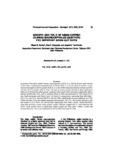Growth and yield of Asian catfish Clarias macrocephalus (Gunther) fed different grow-out diets
- Global styles
- MLA
- Vancouver
- Elsevier - Harvard
- APA
- Help

Download URL
evols.library.manoa.hawaii.edu日付
2003Page views
2,079ASFA keyword
AGROVOC keyword
Metadata
アイテムの詳細レコードを表示する
Share
抄録
Juveniles of the Asian catfish Clarias macrocephalus (3.6±0.17 g; 78.0±0.09 mm) were fed one of four diets: a laboratory-formulated diet of 18.9% (Diet 1) or 34.2% (Diet 2) protein, a com- mercial feed pellet of 28.9% protein (Diet 3) or a diet of 80% blanched chicken entrails and 20% rice bran (31.7% protein; Diet 4). After 120 days of culture, catfish fed Diet 2 grew significantly better (p<0.05) than the other groups, reaching 108.9 g and 232.8 mm (daily weight gain 0.88 g; specific growth rate 2.9%), with a condition factor of 0.86 and production of 18.2 kg per 25 m2 pen. Feed conversion with Diets 2 and 3 (2.5 and 2.3, respectively) was better than with Diets 1 and 4 (3.4 and 5.0). Survival (68-81%) did not differ significantly among treatments (p>0.05). Catfish fed Diet 2 had the highest apparent lipid retention (131.7%). The protein efficiency ratio was lowest (1.3) in Diet 2, but did not differ significantly from Diets 1 and 3. Catfish fed Diet 4 were fatty and had a lower crude protein content. Results suggest that C. macrocephalus fed 34.2% crude protein have a significantly higher weight and total yield. Further, a taste test showed that odor, flavor and appearance did not differ amongst the diets.
Suggested Citation
Coniza, E. B., Catacutan, M. R., & Tan-Fermin, J. D. (2003). Growth and yield of Asian catfish Clarias macrocephalus (Gunther) fed different grow-out diets. The Israeli Journal of Aquaculture-Bamidgeh , 55(1), 53-60. http://hdl.handle.net/10862/1958
Type
ArticleISSN
0792-156XCollections
- Journal Articles [1256]
Related items
Showing items related by title, author, creator and subject.
-
Dietary lipid requirement of whiteleg shrimp Litopenaeus vannamei juveniles cultured in biofloc system
Hamidoghli, Ali; Won, Seonghun; Aya, Frolan ; Yun, Hyeonho; Bae, Jinho; Jang, In-Kwon; Bai, Sungchul C. (Wiley, 2020-06)
An eight-week feeding trial was conducted to evaluate the contribution of biofloc on dietary lipid requirement in whiteleg shrimp Litopenaeus vannamei. Five diets with graded levels of dietary lipid (45, 60, 90, 120 and ...
; Yun, Hyeonho; Bae, Jinho; Jang, In-Kwon; Bai, Sungchul C. (Wiley, 2020-06)
An eight-week feeding trial was conducted to evaluate the contribution of biofloc on dietary lipid requirement in whiteleg shrimp Litopenaeus vannamei. Five diets with graded levels of dietary lipid (45, 60, 90, 120 and ... -
Effect of dietary protein and lipid levels and protein to energy ratios on growth, survival and body composition of the mangrove red snapper, Lutjanus argentimaculatus (Forsskal 1775)
Catacutan, M. R.; Pagador, G. E.; Teshima, S. (Wiley-Blackwell, 2001)The approximate levels of dietary protein and energy that would sustain good growth and survival of the mangrove red snapper Lutjanus argentimaculatus (Forsskal) were determined in two feeding experiments. In the ... -
A new type of fish diet, non-fish meal extruded pellet for yellowtail, Seriola quinqueradiata
Ishida, Noriko; Koshiishi, Tomohiko; Tsuzaki, Tatsuo; Yanagi, Soetsu; Katayama, Satoshi; Satoh, Minoru; Satoh, Shuichi (Aquaculture Department, Southeast Asian Fisheries Development Center, 2015)A non-fish meal diet using plant and/or animal protein materials for yellowtail, Seriola quinqueradiata was developed. Three kinds of non-fish meal diets and a control diet containing 50% fish meal were processed. In the ...




